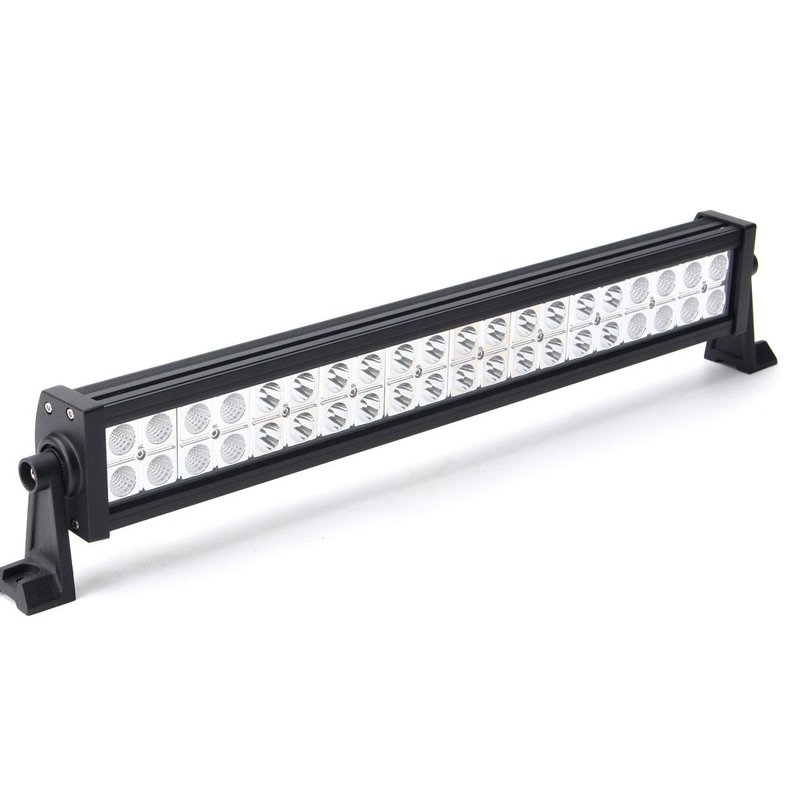欢迎来到 360 Autotek LED 照明公司,我们用各种照明照亮道路。在这篇详细的文章中,我们将探索迷人的 LED 条形灯讨论它们的应用、优点、功能等。无论您是希望提高知识水平的初学者,还是希望获得真知灼见的资深爱好者,本指南都将成为您的首选资源。事不宜迟,让我们开始我们的主题:

LED 灯条:
发光二极管 酒吧灯 是一种高效的多用途照明解决方案,它使用 LED(LED 是发光二极管的缩写)来产生集中而明亮的光线。这些长条形灯具通常由一系列紧密间隔的 LED 灯泡组成,灯泡安装在耐用、耐候的外壳内。安装方式因灯具的大小而异。最常用的安装方式如下:
1.硬支架(稳定性最佳的选择)
2.磁性固定座(可将车灯磁性连接到车辆上)
硬支架的一个例子是警用 LED 条形灯。相反,磁性支架则用于出租车和周围常见的车辆。LED 条形灯有各种尺寸、形状和配置,是各种应用的最佳选择,包括越野照明、汽车照明、家庭和商业用途以及船舶照明。
LED 的概念可以追溯到 20 世纪初,但 LED 在照明领域的实际应用在 20 世纪 60 年代取得了重大进展。然而,直到 20 世纪 90 年代末和 21 世纪初,LED 技术才成熟到可以广泛应用于各种照明领域,包括 LED 条形灯。LED 技术的不断进步提高了 LED 条形灯的效率、耐用性和应用范围。
LED 条形灯因其多种优点而大受欢迎(下一节将详细讨论这些优点)。它们以节能、寿命长和耐用而著称。LED 技术可实现更集中、更定向的光输出,因此非常适合对精确度和强度要求较高的应用,如越野驾驶或户外活动。
此外,LED 条形灯不含汞等有害物质,工作时产生的热量极低,因此非常环保。
LED 条形灯如何工作?
LED 的工作原理是电致发光,即电流通过半导体材料时,半导体材料会发光。在 LED 条形灯中,单个 LED 呈线性排列,电流通过它们。
这就导致了光的发射,产生了强大而集中的光束。 LED 条形灯 这种光源非常节能,因为它们能将大部分电能转化为可见光,与传统照明光源相比,能最大限度地减少热量的产生。

LED 条形灯的部件:
1.发光二极管芯片:发光二极管负责发光。
2.散热器:用于散发发光二极管产生的热量,确保使用寿命和最佳性能的部件。
3.Housing:也称为保护层。外壳可以保护内部元件不受环境因素的影响,具有超强的强度和散热性。例如,压铸铝外壳
4.透镜:透镜:帮助聚焦和形成光束的透明罩。例如,线性透镜和 TIR 透镜
5.安装支架:用于将 LED 条形灯固定在不同表面的组件。例如,铝合金支架
6.接线和连接器:用于电气连接和安装的部件。
7.电源:驱动 LED 条形灯的电力来源。
了解 LED 条形灯的机理、重要性和组成部分,对于在选择和使用这些灯具时做出明智的决定非常重要。 高效照明 解决方案。无论是汽车改装、越野探险,还是其他各种应用,LED 条形灯凭借其先进的技术和多功能的设计,不断照亮前进的道路。
安装 LED 条形灯有什么好处?
安装 LED 灯条具有一系列优点,使其成为各种应用的热门选择。以下是安装 LED 灯条的一些主要优点:
- 能源效率:
LED 灯条具有很高的能效,可将大部分电能转化为可见光。这种能效不仅降低了能耗,还有助于降低电费。
- 寿命长:
与传统照明技术相比,LED 的使用寿命更长。LED 灯条可持续数万小时,长期提供可靠、稳定的照明。这种长寿命减少了更换和维护的频率。
- 耐久性和复原力:
LED 灯条可抵御恶劣的环境条件。它们能抵御振动、冲击和极端温度,是越野车、船舶应用和其他挑战性环境的理想选择。
- 即时照明:
LED 可瞬间点亮,无需其他照明技术所需的预热时间。这种瞬时照明对于需要快速反应的应用(如汽车和应急照明)尤为重要。
- 低热排放:
与传统的白炽灯泡不同,LED 灯条几乎不发热。这不仅有助于提高灯具的安全性,还使其更适合在密闭空间或散热问题突出的区域使用。
- 可定制的灯光模式
许多 LED 灯条都能灵活地调节灯光模式和强度。这种定制功能可让用户根据具体需要调整照明效果,无论是聚焦聚光灯还是更宽的泛光灯。
- 小巧轻便:
LED 技术可实现紧凑轻便的设计。LED 灯条通常外形光滑、低调,易于安装和集成到各种环境中,而不会增加大量体积或重量。
- 环境友好:
LED 技术对环境无害,因为它不含其他照明光源中常见的汞等有害物质。此外,LED 的能效还有助于降低总体碳排放量。
- 颜色选项
LED 灯条有多种颜色可供选择,用户可以根据具体应用选择最合适的色温。这种灵活性有利于营造理想的氛围或提高能见度。
- 低维护:
LED 灯条经久耐用,使用寿命长,长期使用可降低维护成本。由于更换次数少、维护费用低,用户可以享受可靠的照明,而无需频繁地进行维护。

LED 条形灯的应用:
LED 条形灯因其高效率而在各行各业得到广泛应用、 耐用性和灵活性.下面是一些常见的应用:
1.LED灯条广泛应用于卡车、吉普车和全地形车等越野车,可在夜间越野探险时提高能见度。
2.LED 灯条安装在卡车底盘上,用于照亮货物区域,使装卸任务更加轻松。
3.LED灯条是应急车辆照明系统的重要组成部分,可提供高能见度,提高应急响应的安全性。
4.LED 灯条因其耐用性和耐水性,可用于船舶和游艇的导航、聚光灯和一般照明。
5.LED灯条安装在建筑车辆、挖掘机和推土机上,为建筑工地提供明亮的照明,提高安全性和能见度。
6.这种灯条用于农业设备,在清晨或深夜的农场作业中提供有效照明。
7.它们用于营地照明和休闲车(RV),为户外环境提供高效明亮的照明。
8.最后但并非最不重要的一点是,在工业环境中使用它们可以有效地照亮大空间,提高能见度和工人的安全。
9.LED灯条用于安全目的,为建筑物、围墙和其他安全区域的周边提供照明。
10.它们被安装在厨房和其他区域的橱柜下面,用于任务照明和营造氛围。此外,LED 灯条还可用于突出和展示零售环境中的产品,提高能见度和美观度。
11.LED灯条用于房车内部照明和外部照明,以提高车辆周围的能见度。
12.LED 灯条用于花园和景观的重点照明,以突出建筑特色、小径和植物。
13.由于色温和强度可调,LED 灯条被用于娱乐业的舞台照明。
这些应用凸显了 LED 条形灯在不同行业和环境中的适应性,其能效高、寿命长和可定制的特点使其成为首选的照明解决方案。
如何用磁性安装和硬安装方式安装 LED 条形灯?
安装 LED 酒吧灯 使用磁性和硬质支架都需要几个步骤,以确保安装牢固和功能正常。以下是每种安装方式的一般指南:
磁性安装:
所需材料
1.带磁性底座的 LED 灯条
2.干净、平整的金属表面(最好是铁质材料)
3.带开关和继电器的线束(如果 LED 条形灯不包括在内)
安装步骤:
1.在车辆上选择一个干净、平整的金属表面,磁性底座可以牢固地吸附在上面。确保表面为铁质(含铁),以便磁性底座有效吸附。
2.清洁选定的安装区域,去除任何污垢、灰尘或碎屑。清洁的表面可确保更好的附着力。
3.将带磁性底座的 LED 灯条放在选定的表面上。磁铁应将灯条牢牢吸住。调整位置,以达到所需的照明角度。
4.将线束连接到 LED 条形灯上,确保电气连接正确。沿着车架或车内整齐地布线,用拉链扎带或夹子固定。
5.将线束连接到电源,通常是车辆蓄电池。按照制造商的说明进行接线。使用线束上的开关控制 LED 灯条。
6.打开 LED 条形光源,验证其功能和对准是否正确。对角度或位置进行必要的调整。
硬安装
所需材料
1.LED灯条
2.安装支架和硬件(随 LED 条形灯一起提供或单独购买)
3.用合适的钻头钻孔
4.螺丝刀或扳手
5.带开关和继电器的线束(如果 LED 条形灯不包括在内)
安装步骤:
1.确定要在车辆上安装 LED 条形灯的位置。确保所选位置结构合理,光束对准。
2.使用提供的硬件将安装支架固定到 LED 灯条上。根据选定的安装位置摆放支架。
3.安装好支架后,将 LED 条形灯放在所需的位置,并通过支架孔在车辆表面标记钻孔点。
4.用电钻在标记点上钻孔。使用与安装硬件尺寸相适应的钻头。
5.用提供的螺钉将 LED 条形灯固定在安装支架上。牢牢拧紧螺丝,确保灯条稳定。
6.将线束连接到 LED 条形灯上,沿车架布线,并用扎带或夹子固定。
7.按照制造商的接线说明,将线束连接到电源上。使用线束上的开关控制 LED 灯条。随后进行安装测试。

LED 条形灯的维护技巧:
为确保您的设备达到最佳性能和使用寿命 LED 灯条因此,定期维护至关重要。首先要定期检查整个灯具,看是否有损坏、腐蚀或部件松动的迹象。清洁透镜,清除长期积累的污垢、灰尘或碎屑,因为这可能会影响光输出。
检查连接器和接线是否有损坏或磨损,并确保它们连接牢固。如果您的 LED 灯条有散热片,请对其进行清洁,以防止灰尘堆积,确保有效散热。检查安装支架和硬件是否紧固牢靠。此外,还要检查电源,确保其正常工作。
如果您的 LED 灯条 在极端条件下使用的 LED 灯条,例如在越野环境或海洋应用中使用的 LED 灯条,应考虑进行更多的清洁和频繁的检查。总之,积极主动地定期维护不仅能延长 LED 灯条的使用寿命,还有助于在不同应用中实现可靠、稳定的性能。
